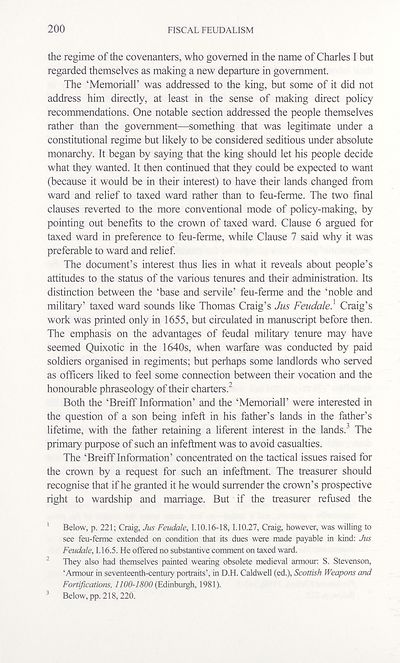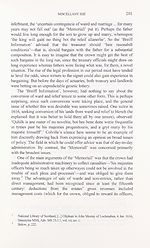Series 5 > Miscellany [of the Scottish History Society] XIII
(215) Page 200
Download files
Complete book:
Individual page:
Thumbnail gallery: Grid view | List view

200
FISCAL FEUDALISM
the regime of the covenanters, who governed in the name of Charles I but
regarded themselves as making a new departure in government.
The ‘Memoriair was addressed to the king, but some of it did not
address him directly, at least in the sense of making direct policy
recommendations. One notable section addressed the people themselves
rather than the government—something that was legitimate under a
constitutional regime but likely to be considered seditious under absolute
monarchy. It began by saying that the king should let his people decide
what they wanted. It then continued that they could be expected to want
(because it would be in their interest) to have their lands changed from
ward and relief to taxed ward rather than to feu-ferme. The two final
clauses reverted to the more conventional mode of policy-making, by
pointing out benefits to the crown of taxed ward. Clause 6 argued for
taxed ward in preference to feu-ferme, while Clause 7 said why it was
preferable to ward and relief.
The document’s interest thus lies in what it reveals about people’s
attitudes to the status of the various tenures and their administration. Its
distinction between the ‘base and servile’ feu-ferme and the ‘noble and
military’ taxed ward sounds like Thomas Craig’s Jus Feudale} Craig’s
work was printed only in 1655, but circulated in manuscript before then.
The emphasis on the advantages of feudal military tenure may have
seemed Quixotic in the 1640s, when warfare was conducted by paid
soldiers organised in regiments; but perhaps some landlords who served
as officers liked to feel some connection between their vocation and the
honourable phraseology of their charters.2
Both the ‘Breiff Information’ and the ‘Memoriall’ were interested in
the question of a son being infeft in his father’s lands in the father’s
lifetime, with the father retaining a liferent interest in the lands.3 The
primary purpose of such an infeftment was to avoid casualties.
The ‘Breiff Information’ concentrated on the tactical issues raised for
the crown by a request for such an infeftment. The treasurer should
recognise that if he granted it he would surrender the crown’s prospective
right to wardship and marriage. But if the treasurer refused the
1 Below, p. 221; Craig, Jus Feudale, 1.10.16-18,1.10.27, Craig, however, was willing to
see feu-ferme extended on condition that its dues were made payable in kind: Jus
Feudale, 1.16.5. He offered no substantive comment on taxed ward.
2 They also had themselves painted wearing obsolete medieval armour: S. Stevenson,
‘Armour in seventeenth-century portraits’, in D.H. Caldwell (ed.), Scottish Weapons and
Fortifications, 7700-/500 (Edinburgh, 1981).
3 Below, pp. 218,220.
FISCAL FEUDALISM
the regime of the covenanters, who governed in the name of Charles I but
regarded themselves as making a new departure in government.
The ‘Memoriair was addressed to the king, but some of it did not
address him directly, at least in the sense of making direct policy
recommendations. One notable section addressed the people themselves
rather than the government—something that was legitimate under a
constitutional regime but likely to be considered seditious under absolute
monarchy. It began by saying that the king should let his people decide
what they wanted. It then continued that they could be expected to want
(because it would be in their interest) to have their lands changed from
ward and relief to taxed ward rather than to feu-ferme. The two final
clauses reverted to the more conventional mode of policy-making, by
pointing out benefits to the crown of taxed ward. Clause 6 argued for
taxed ward in preference to feu-ferme, while Clause 7 said why it was
preferable to ward and relief.
The document’s interest thus lies in what it reveals about people’s
attitudes to the status of the various tenures and their administration. Its
distinction between the ‘base and servile’ feu-ferme and the ‘noble and
military’ taxed ward sounds like Thomas Craig’s Jus Feudale} Craig’s
work was printed only in 1655, but circulated in manuscript before then.
The emphasis on the advantages of feudal military tenure may have
seemed Quixotic in the 1640s, when warfare was conducted by paid
soldiers organised in regiments; but perhaps some landlords who served
as officers liked to feel some connection between their vocation and the
honourable phraseology of their charters.2
Both the ‘Breiff Information’ and the ‘Memoriall’ were interested in
the question of a son being infeft in his father’s lands in the father’s
lifetime, with the father retaining a liferent interest in the lands.3 The
primary purpose of such an infeftment was to avoid casualties.
The ‘Breiff Information’ concentrated on the tactical issues raised for
the crown by a request for such an infeftment. The treasurer should
recognise that if he granted it he would surrender the crown’s prospective
right to wardship and marriage. But if the treasurer refused the
1 Below, p. 221; Craig, Jus Feudale, 1.10.16-18,1.10.27, Craig, however, was willing to
see feu-ferme extended on condition that its dues were made payable in kind: Jus
Feudale, 1.16.5. He offered no substantive comment on taxed ward.
2 They also had themselves painted wearing obsolete medieval armour: S. Stevenson,
‘Armour in seventeenth-century portraits’, in D.H. Caldwell (ed.), Scottish Weapons and
Fortifications, 7700-/500 (Edinburgh, 1981).
3 Below, pp. 218,220.
Set display mode to:
![]() Universal Viewer |
Universal Viewer | ![]() Mirador |
Large image | Transcription
Mirador |
Large image | Transcription
Images and transcriptions on this page, including medium image downloads, may be used under the Creative Commons Attribution 4.0 International Licence unless otherwise stated. ![]()
| Scottish History Society volumes > Series 5 > Miscellany [of the Scottish History Society] XIII > (215) Page 200 |
|---|
| Permanent URL | https://digital.nls.uk/127316109 |
|---|
| Description | Over 180 volumes, published by the Scottish History Society, containing original sources on Scotland's history and people. With a wide range of subjects, the books collectively cover all periods from the 12th to 20th centuries, and reflect changing trends in Scottish history. Sources are accompanied by scholarly interpretation, references and bibliographies. Volumes are usually published annually, and more digitised volumes will be added as they become available. |
|---|


